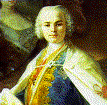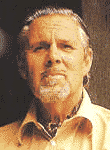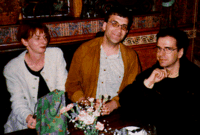 The sopranist, i.e. an adult male singer in the range of a soprano, was very
popular during the Baroque and Classical era, when castrati sang in the opera
in whole Europe. The "primo uomo" was the hero on the stage and his excellent
technique was frequently much more important than the synopsis of the opera.
The most famous castrato was Carlo Broschi, called "Farinelli". In the 19th
century the art of the castrati fell more and more into oblivion, and the last
castrato, Alessandro Moreschi, died in 1922. Their
predecessors were the famous Spanish Falsettists in the cathedrals in the 16th
century.
The sopranist, i.e. an adult male singer in the range of a soprano, was very
popular during the Baroque and Classical era, when castrati sang in the opera
in whole Europe. The "primo uomo" was the hero on the stage and his excellent
technique was frequently much more important than the synopsis of the opera.
The most famous castrato was Carlo Broschi, called "Farinelli". In the 19th
century the art of the castrati fell more and more into oblivion, and the last
castrato, Alessandro Moreschi, died in 1922. Their
predecessors were the famous Spanish Falsettists in the cathedrals in the 16th
century.
|
 At the time of Moreschi's death, the revival of the Baroque opera began in
Germany. The performances had, however, become completely different: the
castrato parts were transposed and sung by baritones and basses, only sometimes
by women in the original range. In the early 50s Alfred Deller began to
perform as a solo countertenor. This pratice of falsetto singing had survived
in the English Cathedral choirs, but the solo countertenor voice, although
having a great tradition, was forgotten. The usual performance practice since
then has been that countertenors sing the alto parts whereas women sing the
soprano parts. The education of these singers, however, goes back to the 19th
century, quite different from that of the virtuoso of the Baroque era.
At the time of Moreschi's death, the revival of the Baroque opera began in
Germany. The performances had, however, become completely different: the
castrato parts were transposed and sung by baritones and basses, only sometimes
by women in the original range. In the early 50s Alfred Deller began to
perform as a solo countertenor. This pratice of falsetto singing had survived
in the English Cathedral choirs, but the solo countertenor voice, although
having a great tradition, was forgotten. The usual performance practice since
then has been that countertenors sing the alto parts whereas women sing the
soprano parts. The education of these singers, however, goes back to the 19th
century, quite different from that of the virtuoso of the Baroque era.
|
 Another milestone was achieved in the 80s when Aris
Christofellis began to perform the castrato rôles in the original
soprano range. The combination of an extraordinary high voice and a
breathtaking virtuosity allowed for the first time since Farinelli's days to
perform Baroque operas with a true "primo uomo". It shall, however, not be
withheld that even the sopranists of our days are still different from a
castrato and some aspects may be better represented by a woman.
Another milestone was achieved in the 80s when Aris
Christofellis began to perform the castrato rôles in the original
soprano range. The combination of an extraordinary high voice and a
breathtaking virtuosity allowed for the first time since Farinelli's days to
perform Baroque operas with a true "primo uomo". It shall, however, not be
withheld that even the sopranists of our days are still different from a
castrato and some aspects may be better represented by a woman.
|
|
The majority of the singers mentioned here are falsettists like Alfred Deller,
but either they developed special techniques to extent their ranges or they
are just tenors whose falsetto range goes beyond the alto range. This page also
includes singers with unusual high voices even if they do not sing in the
soprano range. One case are extremely high tenors, also called tenor
altino or simply male alto. Examples are Russell Oberlin
(who employed the term countertenor for his voice type) and
Rodrigo del Pozo who don't use their falsetto register. Another example is
the very rare case of a
so-called
endocrinological castrato (cf. Kallmann's syndrome), where an hormonal
disorder prevents the voice from breaking. Paulo Abel do
Nascimento, an alto, and Jimmy Scott, a high tenor as
well as the sopranist Radu Marian are such singers.
|
 In our days the composers like Alfred Schnittke, Thomas Bloch, Helmut Oehring
or Peter Eötvös even wrote pieces especially for sopranists. Usually,
they cannot be performed by "normal" countertenors or female singers. But how
did the famous castrati sound? We cannot answer this question. The castrato,
Alessandro Moreschi, was the only one whose voice was
recorded. Unfortunately, his performances are by far away from that of those
singers who once inspired the whole of Europe, but their renaissance has
begun, at least a little bit.
In our days the composers like Alfred Schnittke, Thomas Bloch, Helmut Oehring
or Peter Eötvös even wrote pieces especially for sopranists. Usually,
they cannot be performed by "normal" countertenors or female singers. But how
did the famous castrati sound? We cannot answer this question. The castrato,
Alessandro Moreschi, was the only one whose voice was
recorded. Unfortunately, his performances are by far away from that of those
singers who once inspired the whole of Europe, but their renaissance has
begun, at least a little bit.
|
 The sopranist, i.e. an adult male singer in the range of a soprano, was very
popular during the Baroque and Classical era, when castrati sang in the opera
in whole Europe. The "primo uomo" was the hero on the stage and his excellent
technique was frequently much more important than the synopsis of the opera.
The most famous castrato was Carlo Broschi, called "Farinelli". In the 19th
century the art of the castrati fell more and more into oblivion, and the last
castrato, Alessandro Moreschi, died in 1922. Their
predecessors were the famous Spanish Falsettists in the cathedrals in the 16th
century.
The sopranist, i.e. an adult male singer in the range of a soprano, was very
popular during the Baroque and Classical era, when castrati sang in the opera
in whole Europe. The "primo uomo" was the hero on the stage and his excellent
technique was frequently much more important than the synopsis of the opera.
The most famous castrato was Carlo Broschi, called "Farinelli". In the 19th
century the art of the castrati fell more and more into oblivion, and the last
castrato, Alessandro Moreschi, died in 1922. Their
predecessors were the famous Spanish Falsettists in the cathedrals in the 16th
century.
 At the time of Moreschi's death, the revival of the Baroque opera began in
Germany. The performances had, however, become completely different: the
castrato parts were transposed and sung by baritones and basses, only sometimes
by women in the original range. In the early 50s Alfred Deller began to
perform as a solo countertenor. This pratice of falsetto singing had survived
in the English Cathedral choirs, but the solo countertenor voice, although
having a great tradition, was forgotten. The usual performance practice since
then has been that countertenors sing the alto parts whereas women sing the
soprano parts. The education of these singers, however, goes back to the 19th
century, quite different from that of the virtuoso of the Baroque era.
At the time of Moreschi's death, the revival of the Baroque opera began in
Germany. The performances had, however, become completely different: the
castrato parts were transposed and sung by baritones and basses, only sometimes
by women in the original range. In the early 50s Alfred Deller began to
perform as a solo countertenor. This pratice of falsetto singing had survived
in the English Cathedral choirs, but the solo countertenor voice, although
having a great tradition, was forgotten. The usual performance practice since
then has been that countertenors sing the alto parts whereas women sing the
soprano parts. The education of these singers, however, goes back to the 19th
century, quite different from that of the virtuoso of the Baroque era.
 Another milestone was achieved in the 80s when Aris
Christofellis began to perform the castrato rôles in the original
soprano range. The combination of an extraordinary high voice and a
breathtaking virtuosity allowed for the first time since Farinelli's days to
perform Baroque operas with a true "primo uomo". It shall, however, not be
withheld that even the sopranists of our days are still different from a
castrato and some aspects may be better represented by a woman.
Another milestone was achieved in the 80s when Aris
Christofellis began to perform the castrato rôles in the original
soprano range. The combination of an extraordinary high voice and a
breathtaking virtuosity allowed for the first time since Farinelli's days to
perform Baroque operas with a true "primo uomo". It shall, however, not be
withheld that even the sopranists of our days are still different from a
castrato and some aspects may be better represented by a woman.
 In our days the composers like Alfred Schnittke, Thomas Bloch, Helmut Oehring
or Peter Eötvös even wrote pieces especially for sopranists. Usually,
they cannot be performed by "normal" countertenors or female singers. But how
did the famous castrati sound? We cannot answer this question. The castrato,
Alessandro Moreschi, was the only one whose voice was
recorded. Unfortunately, his performances are by far away from that of those
singers who once inspired the whole of Europe, but their renaissance has
begun, at least a little bit.
In our days the composers like Alfred Schnittke, Thomas Bloch, Helmut Oehring
or Peter Eötvös even wrote pieces especially for sopranists. Usually,
they cannot be performed by "normal" countertenors or female singers. But how
did the famous castrati sound? We cannot answer this question. The castrato,
Alessandro Moreschi, was the only one whose voice was
recorded. Unfortunately, his performances are by far away from that of those
singers who once inspired the whole of Europe, but their renaissance has
begun, at least a little bit.